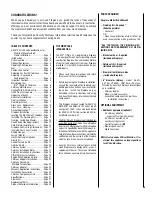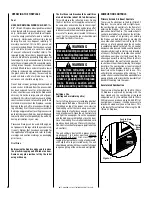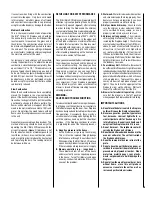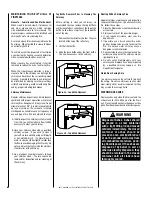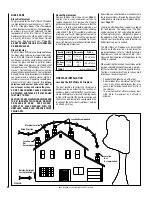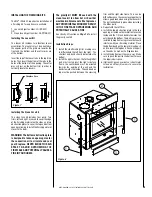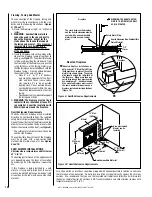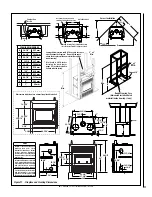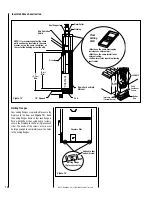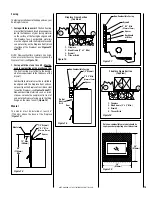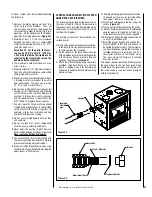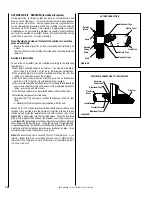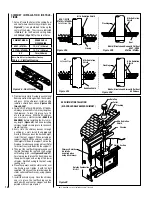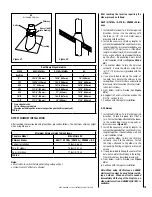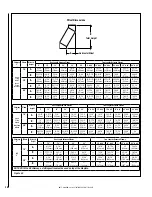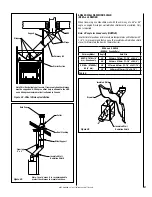
MAINTAINING YOUR BIS
®
Ultima CF
FIREPLACE
Creosote - Formation and Need for Removal
When wood is burned slowly, it produces tar
and other organic vapors, which combine
with expelled moisture to form creosote. The
creosote vapors condense in the relatively cool
chimney flue of a slow-burning fire.
As a result, creosote residue accumulates on the
flue lining. When ignited this creosote makes
an extremely hot fire.
The chimney shall be inspected at least twice
a year during the heating season to determine
when a creosote buildup has occurred.
When creosote has accumulated it shall be
removed to reduce the risk of a chimney fire.
When the creosote accumulation is large, a
creosote fire in the chimney can damage the
chimney and overheat the surrounding wood
framing. Creosote formation in a chimney can
be minimized by making sure there is always
visible flame burning, avoid smouldering fires
and by proper refuelling techniques.
Chimney Maintenance
Regular chimney inspection and maintenance
combined with proper operation will prevent
chimney fires. Keep your chimney clean. Do not
allow more than 1/16” (1.6 mm) creosote build
up in your chimney. The amount of creosote
will depend on variables such as frequency of
use and type of fire. We recommend that you:
A. Initially inspect the chimney system weekly.
From this, you will learn how often it will be
necessary to clean your chimney.
B. Have your chimney cleaned by a qualified
chimney sweep. If you wish to clean it
yourself, we recommend using a stiff plastic
or non-metallic brush. If a metal brush is
used, its size should be slightly smaller than
the flue to avoid damaging the chimney. Do
not use a brush that will scratch the stainless
steel interior of the chimney.
C. Do not expect chemical cleaners to keep
your chimney clean. The rain cap can be
removed for inspection and/or cleaning of
the chimney.
Top Baffle Removal Prior to Cleaning The
Chimney
Before starting to clean your chimney, we
recommend that you remove the top baffle to
avoid creosote dust collection at the top of the
baffle. Follow these steps to set the top baffle
out of the way:
1. Remove the side refractory holder. They are
located at the top of the refractory.
2. Lift the front baffle.
3. Slide the back baffle under the front baffle.
You now have access to the chimney.
WARNING
Disposal of Ashes: Ashes should
be placed in a steel container
with a tight fitting lid and moved
outdoors immediately. The closed
container of ashes should be
placed on a non-combustible floor
or on the ground well away from
all combustible materials, pend-
ing final disposal. If the ashes are
disposed of by burial in soil or
otherwise locally dispersed, they
should be retained in the closed
container until all cinders have
thoroughly cooled.
Dealing With a Chimney Fire
Regular chimney maintenance and inspection
can prevent chimney fires. If you have a chimney
fire, follow these steps:
1. Close the fireplace door and the combustion
air controls.
2. Alert your family of the possible danger.
3. If you require assistance, alert your fire
department.
4. If possible, use a dry chemical fire extin-
guisher, baking soda or sand to control the
fire. Do not use water as it may cause a
dangerous steam explosion.
5. Check outside to ensure that sparks and hot
embers coming out of the chimney are not
igniting the roof.
6. Do not use the fireplace again until your
chimney and fireplace have been inspected
by a qualified chimney sweep or a Fire
Department Inspector.
Finish Door Casing Care
Use a glass cleaner and a soft cloth to polish
the casing. Do not use abrasives such as steel
wool, steel pads or an abrasive polish for they
may scratch the casing’s finish.
DISPOSING OF ASHES
Remove ashes only when the fire is out and the
ashes are cold (24 to 48 hours after the fire is
out). Do not leave the ashes in the house as they
give off carbon monoxide and other toxic gases.
Figure 2b - Top Baffle Removal
Figure 2a - Top Baffle Removal
NOTE: DIAGRAMS & ILLUSTRATIONS ARE NOT TO SCALE.
6



